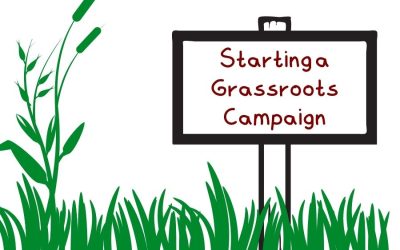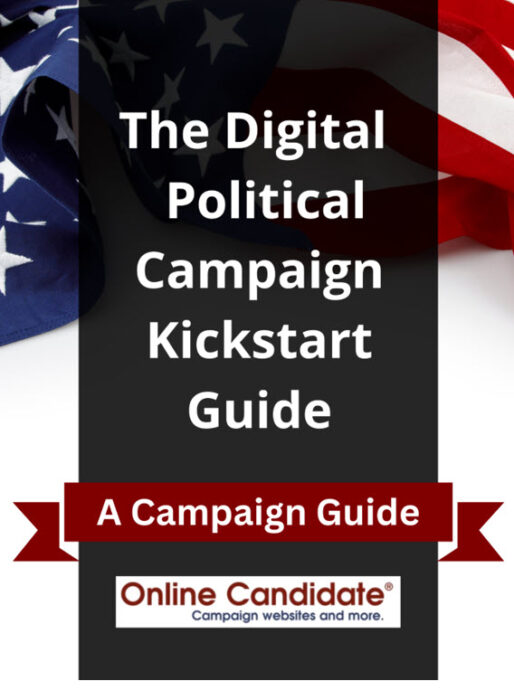A List of Our Best School Board Campaign Slogans
As a candidate running for school board, you’ll want to stand out from the other candidates. Good school board campaign slogans help keep candidates in the minds of voters.
As a school board member, you will take an active role in your community. You will have a hand in the policies and issues that effect your local school district, teachers and students. Your election slogan should best reflect your priorities as a candidate.
Examples of our best slogan ideas for school board candidates:
- Better Schools For A Better Tomorrow
- Working for a Better Classroom
- Academic Excellence Today
- Putting Students First
- Make our Schools Great
- Restore our School District
- Working for Our Children
- A Positive Voice For Our Children
- Improve our Schools
- Valuing our Children’s Education
- Working for a Better District
- Protecting Your Tax Dollars
- Education is Key
- Hard Choices, Better Schools
- Common Sense Solutions
- Education First
- Better Schools for a Better Future
- Your Voice on the Board
- An Advocate for our Youth
- A Good Education is Elementary
- Accountability and Integrity
- Inspire our Students to Achieve
- Vote for Improved Education
- Raise Your Voice, Make a Choice
- Stop the Violence
- For a Smarter Curriculum
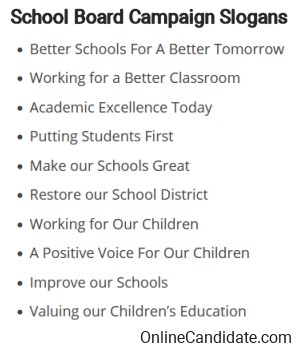
How to create a great campaign slogan that speaks to voters
- Come up with a few of the most important issues facing your school district. They may already be part of your school board campaign platform.
- Are there any hot topics that are of interest to voters and will inspire them to turn out at the polls? They may be the reasons why a parent is considering whether to send their child to your district. Other issues often include the school district’s budget, school safety and security, teacher quality or effective career paths for students.
- Brainstorm a few slogan ideas and refine them.
- Choose your final slogan and use it in your logo, signs and print material.
Elections for school board often have low voter turnout. It’s important to stand out from your opponents. A catchy slogan can boost your exposure and help you win your election.

Start your website for school board with Online Candidate. We’ve got the expertise, the resources, and the affordability you need to win. Contact us today to get started!
Related articles:
Judicial Campaign Logo Design
The use of campaign logos for judicial elections is a relatively recent phenomenon and it has been found to play a significant role in the success of a campaign. A judicial campaign logo allows supporters to easily identify and associate themselves with a candidate. They can be seen as an indicator of the candidate’s judicial temperament, priorities and values.
Want a FREE logo design for your campaign?
Our custom political website packages include a free professional logo design. Hiring a professional political graphic designer is expensive. So is using a logo maker that charges to download a decent quality graphic file – and only tells you after you’ve done the work!
Regardless of who does the work, you will need a high-resolution logo file. Web graphics are created in low resolution. Brochures, print material, and yard signs require graphic files of higher quality. We provide our clients with high-resolution logo files for free so your branding is consistent.
Judicial candidates in particular tend to fall under local rules or restrictions for judicial signage. There may be regulations on using certain imagery or text. Be sure to know any existing rules so you don’t run into problems later. If we suspect an potential problem while we are creating your graphics, we’ll let you know.
Sample judicial candidate logos

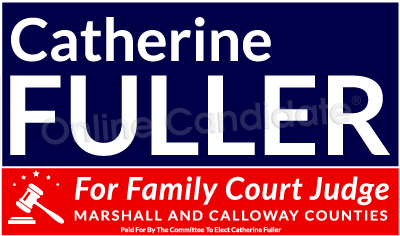

Judicial Logo Tips
- Keep the design simple and dignified. Many candidates for judge use a serif font, as it is reminiscent of law firm branding. However, script lettering is more challenging to read and may not translate well in print. It’s a good idea to keep the design simple and stay away from complicated graphics that take away from the candidate’s name.
- Incorporate legal symbols. We often incorporate graphic elements such as a gavel or scales of justice. They are done in a way that lets voters know that the candidate is for judge.
- Limit the color scheme. Judges tend to go with black and white or red and black. Odd colors may get attention but may also distract from the messaging. The position of judge lends itself well to stark, strong impressions.
- Keep your look consistent. Much of your voter branding comes from your logo. If you change it during your run for office, you’ll lose much of that connection.
Judicial campaign logo templates are also available for download
Don’t need a website? We carry judicial candidate logo templates for both Adobe Photoshop and Canva. Either a free Canva account or Adobe graphic software is required, depending on the template purchased. We also offer political graphic design services.
Our Custom Judicial Website Packages includes a free custom logo design and header. We’ll also provide high-res versions for your print material. Why pay hundreds of dollars to have a designer just create a logo? We’ll make one for you – and it’s included with your website.
Related:
So You Want To Run For Sheriff? Here’s How To Get Started
A sheriff is normally the chief law enforcement officer of a county. They are usually elected by the people who live in their jurisdiction and have many roles and responsibilities.
As sheriff, you are mostly involved with keeping people safe by upholding the law. You must make sure that there is law and order in your county to protect people.
A sheriff’s duties include:
- Keeping the peace and enforcing the law
- Investigates crimes that take place in their jurisdiction
- Presiding over the county jail
- Acting as law enforcement for unincorporated areas of the county,
- Providing security at local government buildings like court houses and voting precincts
- Maintaining law and order in large public events while working with other law enforcement agencies (like police departments)
- Handling emergency situations
A sheriff’s department has jurisdiction over a small area, usually a county, and deals with crimes that range from public order to homicide.

Did you know? The word “sheriff” comes from the Anglo-Saxon words “shire reeve” which means “county protector.” It was originally used to describe their role as an officer or overseer of a shire or territory at least two centuries before police forces existed.
What are the requirements to run for sheriff?
Qualifications to be a sheriff are often not hard to meet. You must be a qualified voter in the county where you are running for sheriff. Other qualifications may include:
- Be at least twenty-one or twenty-five years of age or more
- Have a clean criminal record
- Pass the position’s physical agility test
- Demonstrate your ability to write proficiently
- Complete any required training programs
You may be ineligible to be sheriff if you are:
- Currently suspended or discharged from any public office
- Convicted of a felony
- Previously removed from office by court order
The term of office for a sheriff usually lasts four years with no term limits.
What does it take to win an election as a sheriff candidate?
Running for office can be a complex and daunting task. Some people argue that you don’t need experience to be elected as a public official. However, the head of county law enforcement requires skills that come from experience – such as speaking in front of large crowds or being able to handle sensitive information with discretion.
There are certain things to know that will help you to prepare for your campaign. One is being aware of your strengths and weaknesses. You should know what your vision is, what policies you want to achieve as sheriff, and how you plan to do it.
Some common issues in sheriff campaigns
There are many community issues that a sheriff department faces. A candidate needs to know what they stand for, their policies, and how they will address community issues.
Some of the challenges that sheriffs face include:
- Public safety and crime
- Budgetary concerns
- Effective communication between law enforcement and the community
- Overcrowding in jails
- High recidivism rates
- Making jails safer and more efficient
The sheriff’s office must find innovative ways of tackling these problems. A sheriff’s job is not just about arresting criminals and locking them up in jail. They must also be an active part of the community and help bring about real change.

Problems with county jails are often an issue in sheriff election campaigns.
Creating a brand for your campaign
In many ways, the process of running for office is like creating and promoting a brand. Political campaigns must choose a slogan, create a logo, and choose colors before they can start building a website or creating print materials and signage.
Most sheriff candidates brand their campaigns tend to be one or more of these colors:
- Blue: This color stands for security and trust. It has a strong connotation to law enforcement, which is why it is a good color choice for sheriff.
- Gold: This color offers an elegant touch, while still indicating strength and professionalism.
- Black: This color tends to be associated with power, strength, and authority.
One of the most recognizable symbols for authority in the US is a Sheriff badge. Most sheriff candidates include a badge within their campaign logo design. There are many distinctive styles for sheriff badges, but they all tend to be in the shape of a star. Departments have different badges; some are sided with five points while others use six-point stars.
Note: Most sheriff candidates may not use a photograph of themselves wearing a badge in campaign materials.

A sheriff’s logo should show their seriousness and authority. The logo should be clean, simple, and direct. It needs to convey that the sheriff’s office is there to protect the community.
How to campaign as a sheriff candidate
To get elected as a sheriff, it is important to have a plan of action. This plan should include how you are going to promote your campaign, who you’re going to target, and what issues you’re going to address.
You should make your campaign is based on substance, not soundbites. To get the support of voters, you need to tell them what your plans are for improving their safety.
Local campaigns traditionally use signs, brochures, texting, and phone banking as the main ways of communicating with voters. Promoting yourself door-to-door is a time-honored and effective tradition, but it can be exhausting canvassing from house to house.
Volunteers
Volunteers are needed for a local campaign to further the candidate’s chance of winning. Volunteers help organize fundraisers and canvass in neighborhoods. The power of a campaign can be amplified when people are willing to help. This is why grassroots campaigning relies on volunteers and supporters.
Fundraising
Successful fundraising events are crucial to the success of a campaign. When you are trying to fundraise for a local political campaign, you need to know your audience and its interests. Typical fundraisers include different dinners, rallies, speeches, and outdoor events.
Online campaigning
Today, most county sheriff departments use social media to get the word out about upcoming events, traffic updates, and crime prevention tips. There are also many sheriffs who use sites like Facebook, Twitter, and Instagram to help identify criminals. They may post pictures of suspects to get the public’s attention so they can identify the person.
Social media can be used as campaign promotional tool as well. Growing followers on Facebook and Twitter is fine, but paid online advertising is necessary to reach that audience. Of the two, only Facebook allows online advertising on its platform, and you’ll need to be authorized to run ads.
Campaign websites are the most important part of any digital promotion. A good website will promote your candidacy, educate voters, and even raise funds.
Getting voters to remember you on Election Day
Most voters don’t pay much attention to local politics, so a lot of people may be unaware of your upcoming sheriff’s election. Your campaigning goal should be to promote yourself and lay out your vision so that voters remember you on Election Day.
Other Frequently Asked Questions
Do I need a law degree to get elected as Sheriff?
The requirements for becoming a sheriff vary based on the jurisdiction in which the person is located. However, they do typically require some form of secondary degree. A law degree is not generally required, though it may be preferred depending on the jurisdiction.
Are there any professional licenses or certification required to become a sheriff?
One of the most common misconceptions about sheriffs and deputy sheriffs is that there is a professional license or certification required to become one. It is possible to become a sheriff or deputy without any licensing requirements at all.
What does it take to become a Deputy Sheriff?
Deputy sheriffs are law enforcement officials that serve at the local level. They are responsible for enforcing state laws, except for federal crimes.
The requirements for becoming a deputy sheriff vary from location to location. Most deputy sheriffs attend a police academy after graduating high school and completing some college credits. The requirements vary by state, but generally include passing a written exam, physical exam, and background investigation before they can be sworn into office.
Build your sheriff campaign website with Online Candidate. With simple pricing and easy to use features, we help hundreds of candidates each election cycle.
Related Posts
Who To Contact If You Want To Run For Office
“A journey of a thousand miles begins with a single step.” This is an old Chinese proverb meaning that great things start from simple beginnings.
Sometimes that first step begins with a basic question. If you want to run for public office in U.S., the most common question is, “who should I contact when starting my political campaign?”
Key Takeaways
- State or Jurisdiction’s Election Website: For filing dates, campaign requirements, and necessary paperwork.
- Local Clerk’s Office: Essential for obtaining the specific forms and applications needed for the race.
- Political Consultants and Experienced Candidates: They offer valuable insights and guidance on the campaign process, based on their expertise and past experiences.
The last few election cycles have seen a surge of people interested in seeking elected office. There are record numbers of Millennials and women getting involved in the political process. If you’ve never run for office before, you’re going to need help learning what it takes to get elected.
Fortunately, resources exist to help first-time candidates navigate the guidelines, rules, paperwork, and best practices.
Related: Should You Make The Run For Local Office?
Before you begin campaigning, you must determine what office to run for. Many people start locally. This could be a run for city council, village council, school board, or municipal district. Some elected positions are part-time; others are full-time. All of them require a commitment that can last several years.
Who to contact to start your political campaign
There are several places you can reach out to for help when looking to run for elected office. They include:
- Your state’s or jurisdiction’s website
- Local clerk
- Political consultants
- Others who have experience running for the office you seek.
Your state’s or jurisdiction’s election website can provide filing dates and campaign requirements. Contact your local or county clerk’s office for the necessary paperwork you’ll need for the race you intend to run in. This can include petition forms, applications, disclosures, and other filing forms.
You may want to reach out to political consultants who have experience operating campaigns within your jurisdiction. They should know the process of starting a political campaign.
Others who have run for the office you seek may be able to provide valuable insights. They can be incumbents or previous candidates. Since they have already run a campaign, they should be familiar with the process. They may also be able to put you in contact with others they have worked with. Even a perennial candidate can be helpful through their own experience.
Tell no one?
Some people wait to start because, for some reason, they want to keep their candidacy a secret. We once had a local village candidate hold off announcing his candidacy until only a week ahead of the election because he didn’t want to, quote, ‘tip his hat.’
The problem with that strategy was that he didn’t have time to do any advertising. He was well-known to residents, but most probably did not know that he was in the race until they saw his name on the ballot on Election Day.
As you can probably guess, he lost.
While you might not want to make your candidacy known too early, you should learn as much about the process as you can. Once you make any filings or tell people your plans, you can count on the fact that word WILL get out that you are running.

How to register as a candidate
To officially start and run a political campaign, you’ll need to register to run for office. If you have met the eligibility requirements for the office you seek, you can declare your candidacy.
You will need to submit your paperwork in person or by mail by the proper deadline.
Registration provides notification of your candidacy and allows you to form a political committee. You will need a formal organization to open a bank account and start working with campaign contribution vendors.
Who you register your campaign with will vary depending on whether you are running for a federal, state, or local office. The general information required during the process includes the following:
- Candidate’s full name and contact information
- Office sought, including the district and time lived there
- Party affiliation
- Committee name
Guidelines and requirements for various offices can vary. State representatives or state senate candidates should consult their state’s procedures and requirements. In most cases, you will file your paperwork with your secretary of state’s office.
For many elected positions, you’ll need to reside in the state, municipality, or district that you want to represent. There’s also usually a time requirement for residency.
- Running as a party candidate will give you access to more information and resources. Political parties also help recruit and nominate candidates. Third parties rarely win elections, but they play an important role in introducing new ideas or pushing specific issues.
- Judicial candidates often run without any party affiliation. Many states hold non-partisan elections for judges, prosecutors and district attorneys.
- If you are running for federal office, you must register and file financial reports with the Federal Election Committee when you raise or spend more than $5,000 in contributions or expenditures.
At this stage, you are registering yourself as a candidate. Registering to appear on a ballot for a primary or general election will come later.
“Give me six hours to chop down a tree and I will spend the first four sharpening the axe.” –
Reach out and skill up with candidate training
There are organizations that help train candidates of all types. Here are a few that offer online courses:
- American Majority offers online training for conservative candidates.
- Emily’s List helps train Democratic women.
- FEC offers opportunities for training on the federal campaign finance laws.
- GOP Political Education provides candidates, campaign managers, and staff with tools and information.
- National Democratic Training Committee offers free training for all Democrats and Progressives.
These are just a few from our full list of organizations that provide political training courses.
Knowing where to start can be overwhelming for those new to the political sphere. There is a lot of help out there – certainly more than there was 5 or 10 years ago. Take the time to prepare yourself before jumping into a race.
FAQs
Who should I contact first when deciding to run for office?
Your first step should be to consult with your local election office or state election board. They provide essential information on eligibility, filing deadlines, and specific documentation required for candidacy.
Can political consultants help in my campaign?
Engaging political consultants can be a strategic move. They bring expertise in campaign planning, voter outreach tactics, media management, and can help tailor your message to resonate with your targeted audience.
Should I seek advice from current or former elected officials?
Gaining insights from current or former elected officials is invaluable. They can share practical advice on campaign strategies, balancing public responsibilities, and the nuances of legislative work.
How important is it to connect with local political parties?
Involvement with local political parties is essential for garnering support. They offer not just endorsements but also access to a network of potential volunteers, donors, and logistical support crucial for campaign execution.
What role does the Federal Election Committee (FEC) play for federal candidates?
For federal campaigns, the FEC is your go-to for understanding financial regulations. They provide guidelines on fundraising, expenditure reporting, and ensure your campaign adheres to legal financial practices.
Online Candidate website clients have access to OnlineCandidateResources.com for free articles, tools, graphics and additional resources.
Combining Political Print and Digital Marketing Strategies
Campaign advertising has always been a powerful tool for politicians. Marketing for politicians provides an effective way to get their message across to voters. Winning campaigns use a combination of traditional media, print, and digital marketing. They often combine these mediums to improve their effectiveness.
For example, using both mailers and online ads increases the touch points that voters have with your political campaign.
Print not only encompasses mailers and campaign brochures, but also newspapers and other forms of advertising, including billboards and signage. Digital ads include pay per click, Facebook promotion, display ads, and IP targeting.
Advantages to combining print and online advertising:
- Augment your channels: By combining both forms of advertising, you’re augmenting your channels to reach your specific voter audiences.
- Improve your reach: Print ads can drive your digital marketing. By including strong calls to action (CTA) with website addresses, social media links and hashtags, you can extend your reach and exposure to your online presence. From there, you can further engage voters and supporters through email, IP Targeting and other digital methods.
- Increase your impact: In a study conducted on behalf of the U.S. Postal Service, print media was found to outperform online material in review time and awareness. While you can measure digital response and reach, brand awareness can benefit from a dual-approach.
Tips to improve your combined print and digital strategy
 Use consistent branding and messaging
Use consistent branding and messaging
To truly make an impression, make sure that your campaign branding is consistent across all formats to reinforce your message. Complementary design is important. Different online and print campaigns that do not match in look or tone will not be successful. Your printer should have access to your image and logo creatives and/or they should be provided for your web ads and banners. Consistent branding should also apply to any television or cable ads you run.
If your logo has been created by Online Candidate, we can provide a high-resolution version in different formats for your print advertising.
Use campaign hashtags in print
Trying to draw attention to a particular issue that you are promoting on social media? Adding specific hashtags to your print materials is a way to funnel your marketing channels. Including a call-to-action to share on social media combines the two strategies for a greater impact.
Try friendly links
Add a user-friendly URL in your mailers. This is useful if your regular website domain is difficult to type or if you want to send visitors to a specific place online. A URL redirect can make it easy to send a visitor directly to the page you want. Unique links in advertising can even be used to track the effectiveness of a particular marketing push.
Need help setting up a redirect? Put in a support request, and we’ll get you set right away.
Using a relevant landing page
You can always send people to your campaign website’s home page. But if you send someone directly to a landing page, you should make sure that page matches the call to action in your ads.
Time your promotions
Time-sensitive calls to action can be particularly effecting. This not only include Election Day, but also the primary election day, date to start early voting, and the date when voting ends. Use your election calendar and be strategic when releasing new print pieces and online ads.
Voter advertising is especially important in primary elections, where voters can’t use party identification of Democrat or Republican to choose a candidate. With less information, voters can be more persuaded by additional information provided in ads.
Though print and political digital ads are different and engage voters in different ways, the two formats complement one another. With a strategy of consistent branding and messaging, print and digital campaigns can direct attention to one another, get voters engaged, and bring more attention to a candidate.
Online Candidate provides affordable political websites and political graphic design services to help you get started fast. For custom design services, we can provide a high-resolution version of your logo or graphics for your print advertising needs.
Starting a Local Grassroots Political Campaign
Starting a local grassroots campaign is challenging. But with commitment and the right strategy, you can make a meaningful impact in your community. This guide will walk you through the steps to successfully launch your local grassroots campaign, from planning to execution. We’ll discuss building diverse support, storytelling, and the role of technology in modern campaigning.
The first and most necessary step to launch a grassroots campaign is to decide what type of campaign you want to run. Do you want to run for public office? Are you going to become an activist? Do you want to be a voice for your community? Your campaign’s purpose will shape the strategy, outreach methods, and resources you’ll need.
Mobilizing people in your community around your political cause or goal can be done by registering people to vote, assisting with absentee ballots, or simply talking with them about what’s important to you and why they should care. Many successful campaigns start with neighborhood voter drives, building trust one conversation at a time. The people who will join your campaign will share the same interests and values as you do.
If you are planning to run for office, you will need to register as a candidate with the appropriate election commission in your state, county, or municipality. If you are not part of a political party, you will need to do much of the work yourself just to get on the ballot.
However, to organize broader support to win an election, you will need to get your name out there and start building your movement.
Free Tool: Are You Ready to Run for Office? Take a Self-Assessment Survey.
What is a grassroots political campaign?
Traditional political campaigns focus on gathering large sums of money and using this money to influence voters and persuade them to either vote for a specific candidate or get large numbers of individuals to contact policymakers to take action on a particular issue or cause.
In contrast, a grassroots campaign is usually initiated by an individual or small group that aims to persuade others about their cause for an issue, a political candidate, or other type of social change.
For local elections, grassroots efforts are more personal than traditional campaigning. They require more direct involvement with people in their community. This includes door-to-door canvassing, letter-writing campaigns, activist and volunteer activities, and voter mobilization. Real, one-on-one connections make grassroots efforts powerful tools for local change.
Steps to start a local grassroots campaign
The opportunity to change the fate of your local city, town, village, or state is not just reserved for well-funded politicians and wealthy backers. Anyone and everyone can launch grassroots and reform campaigns.
There are many reasons why one would want to start a grassroots campaign, from advocating for an issue to raising awareness about a candidate. Grassroots campaigns can provide enormous opportunities for policy change and have a big impact on public opinion.
A written strategy helps you figure out the steps you need to take to reach your advocacy goals. This makes it easier to focus on each task and avoids “analysis paralysis.”
A successful grassroots strategy follows these five fundamentals:
- Have a clear objective
- Identify your target audience
- Have an effective outreach plan for building community support
- Ongoing communication
Create a winning message to mobilize support
An effective grassroots message resonates with an audience and is something people can associate with. To do this, use storytelling techniques to create a emotional connection. Stories with real people and relatable characters are more compelling than just data and statistics.
It’s important to have a clear goal in mind when you start. What are you trying to achieve? For example, if you are running for local office, your goal is to win the election. For messaging from political grassroots groups to succeed, they need creative messages that people can connect with emotionally.
For example, if you want people to donate money to your campaign, you should have goals to reach that require a certain amount of money to be raised in a certain time frame. The more specific the goals, the easier it is to create an engaging message. Specific requests tend to resonate with voters or potential donors better than generic requests for help.
Without a unifying message, it’s hard to rally support for any cause. The best political messaging is interesting, memorable, and compelling. It must have a purpose and be focused on your supporters’ needs and desires. Successful advocacy groups use creative messages that people can connect with on an emotional level.
Free Campaigning Tips: Subscribe for free guides and updates from Online Candidate.
Raising funds for your grassroots campaign
Raising money to support grassroots campaigns is always a challenge. Start by focusing your efforts on your inner circle—those already invested in your cause or most likely to contribute. This approach helps create a sense of ownership and helps ensure your early supporters will retain long-term commitment.
Besides the money angle, effective fundraising is about building relationships and sustaining momentum. Grassroots campaigners should think outside the box and explore creative strategies, such as hosting community events, leveraging crowdfunding platforms, or partnering with local businesses. Consider sources of funding you may have overlooked, like in-kind donations that can offset expenses.
Regularly engage with your donors to keep them connected to your campaign and the candidate’s progress. Paying attention to their feedback and interests will help you understand how they can contribute even more effectively in the future.
Recruiting volunteers and growing support
Volunteers are an important part of grassroots advocacy campaigns. Volunteers help sustain and lead your efforts, so it’s important to develop a clear strategy for recruitment and building a solid campaign team.
Create a volunteer persona to identify who your likely supporters are and what issues they are passionate about. Target these groups with personalized messaging. Empower your volunteers by grouping them based on their skills and interests, then training them to be effective advocates.
For example, if you’re campaigning against local overdevelopment, homeowners in affected neighborhoods may become your most passionate supporters. Try to find people with relevant expertise and skills who can help bring others into the fold.
Work to create an inclusive environment where there is strong communication and cooperation. This will help volunteers work on projects where they can best contribute their talents and resources.
Local community building and organizing
Grassroots success starts with strong local connections. Leverage your local media, neighborhood associations, and any relationships or partnerships with community leaders to amplify the reach of your message. Town hall meetings, grassroots petitions, and events at community hubs like libraries or parks are great ways to gather support.
To help outreach, do the following:
- Create a website for your primary messaging and online organizing.
- Use social media platforms like Facebook, Instagram, and X / Twitter to spread your message and engage with supporters.
- Get the candidate and volunteers involved in the ground game through local events and door-to-door canvassing.
- Start an email and texting program to keep everyone in touch.
- Use software to organize volunteers, track spending and track voter trends.
Real, boots-on-the-ground field work is how you’ll make a difference. Campaign that are involved regular canvassing see voter turnout increase in their district. Combine digital outreach with in-person efforts to maximize your impact.
Grassroots advertising budgets are generally less than those of well-funded political campaigns. This may limit expensive advertising mediums like TV ads or billboards to get their message across.
Run an effective social media campaign to reach voters
Producing content for social media is one of the most important aspects in running a successful campaign. Use social media platforms like Facebook, Twitter, and Instagram to organize efforts, fundraise and get the word out about your cause.
For example, if you wanted to promote an upcoming campaign event, you could create a Facebook even for people who are interested and send them notifications. You may need to pay to promote posts to ensure your messages reach your followers, but that is inexpensive and very targeted advertising.
Social media campaigns have become a major part of digital politics. Today, all political parties and most candidates use social media platforms to reach voters and supporters. The importance of digital campaigning makes it imperative for organizations to have a well-thought plan in place.
Conclusion:
Starting a local grassroots campaign gives new candidates and advocates the opportunity to build a meaningful presence in their communities. By focusing on strategic planning, local outreach, and community-driven fundraising, you can inspire change and make a lasting impact on Election Day.
Related:








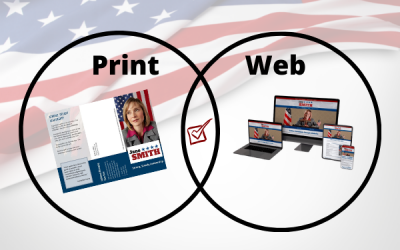
 Use consistent branding and messaging
Use consistent branding and messaging
